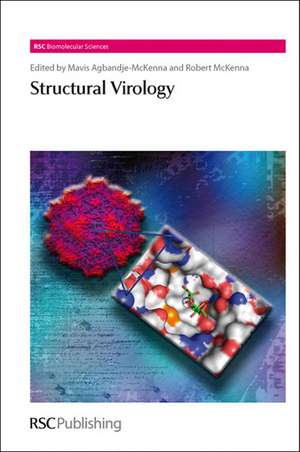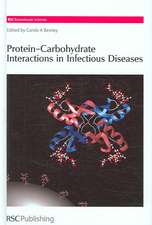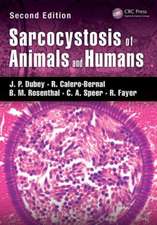Structural Virology: RSC Biomolecular Sciences (Numbered), cartea 21
Editat de Mavis Agbandje-McKenna, Robert McKennaen Limba Engleză Hardback – 31 oct 2010
Over the last ten years, much effort has been devoted to improving the biophysical techniques used in the study of viruses. This has resulted in the visualization of these large macromolecular assemblages at atomic level, thus providing the platform for functional interpretation and therapeutic design. Structural Virology covers a wide range of topics and is split into three sections. The first discusses the vast biophysical methodologies used in structural virology, including sample production and purification, confocal microscopy, mass spectrometry, negative-stain and cryo-electron microscopy, X-ray crystallography and nuclear magnetic resonance spectroscopy. The second discusses the role of virus capsid protein structures in determining the functional roles required for receptor recognition, cellular entry, capsid assembly, genome packaging and mechanisms of host immune system evasion. The last section discusses therapeutic strategies based on virus protein structures, including the design of antiviral drugs and the development of viral capsids as vehicles for foreign gene delivery. Each topic covered will begin with a review of the current literature followed by a more detailed discussion of experimental procedures, a step in the viral life cycle, or strategies for therapeutic development. With contributions from experts in the field of structural biology and virology this exceptional monograph will appeal to biomedical scientists involved in basic and /or applied research on viruses. It also provides up-to-date reference material for students entering the field of structural virology as well as scientists already familiar with the area.
Preț: 1143.04 lei
Preț vechi: 1203.21 lei
-5% Nou
Puncte Express: 1715
Preț estimativ în valută:
218.75€ • 237.53$ • 183.75£
218.75€ • 237.53$ • 183.75£
Carte tipărită la comandă
Livrare economică 22 aprilie-06 mai
Preluare comenzi: 021 569.72.76
Specificații
ISBN-13: 9780854041718
ISBN-10: 0854041710
Pagini: 371
Dimensiuni: 157 x 240 x 26 mm
Greutate: 0.74 kg
Ediția:Edition.
Editura: Royal Society Of Chemistry
Seriile RSC Biomolecular Sciences, RSC Biomolecular Sciences (Numbered)
ISBN-10: 0854041710
Pagini: 371
Dimensiuni: 157 x 240 x 26 mm
Greutate: 0.74 kg
Ediția:Edition.
Editura: Royal Society Of Chemistry
Seriile RSC Biomolecular Sciences, RSC Biomolecular Sciences (Numbered)
Cuprins
Introduction: Principles of Virus Structure;Section 1 Methodologies for Structural Analysis of Viruses; Production and Purification of Viruses for Structural Studies; Microscopic (Confocal) Analysis of Viral Entry and Infection; Cryo-electron Microscopy of Virus Infection - Tomography and Asymmetric Structure Determination; Cryo-electron Microscopy of Viruses - 3D of Virus Capsids; X-ray Crystallography of Virus Capsids; Structural Studies of Viral Proteins; Probing Viral Capsid Structures in Solution; Section 2 Structure to Function Correlation for Viruses; Evolution of Viral Capsid Structures - the Three Domains of Life; Mechanisms of Virus Capsid Assembly; Mechanisms of Genome Packaging; Attachment and Viral entry - Receptor Recognition in Viral Pathogenesis; Attachment and Entry - Viral Cell Fusion; Virus Antibody Recognition; Section 3 Therapeutic Strategies Based on Viral Structures; Development of anti-HIV drugs; Design of Influenza Vaccines and Antiviral Agents; Engineering Viral Capsids as Nano Tools; Viral Vectors for Gene Delivery;
Notă biografică
Mavis Agbandje-McKenna is currently Director of the Center for Structural Biology and Associate Professor at the University of Florida College of Medicine. She obtained her BSc (Hons) in Human Biology and Chemistry from the University of Hertfordshire and a PhD in Biophysics at the University of London Institute of Cancer Research. Her postdoctoral research was at Purdue University before she was appointed Senior Research Fellow at the University of Warwick, UK. Robert McKenna obtained his BSc (Physics and Biology) and PhD in Crystallography from the University of London. His postdoctoral research was at Purdue University before he accepted the post of Warwick Research Fellow in the Department of Biological Sciences at the University of Warwick. He is currently Associate Professor at the University of Florida College of Medicine.
Textul de pe ultima copertă
Over the last ten years, much effort has been devoted to improving the biophysical techniques used in the study of viruses. This has resulted in the visualization of these large macromolecular assemblages at atomic level, thus providing the platform for functional interpretation and therapeutic design. Structural Virology covers a wide range of topics and is split into three sections. The first discusses the vast biophysical methodologies used in structural virology, including sample production and purification, confocal microscopy, mass spectrometry, negative-stain and cryo-electron microscopy, X-ray crystallography and nuclear magnetic resonance spectroscopy. The second discusses the role of virus capsid protein structures in determining the functional roles required for receptor recognition, cellular entry, capsid assembly, genome packaging and mechanisms of host immune system evasion. The last section discusses therapeutic strategies based on virus protein structures, including the design of antiviral drugs and the development of viral capsids as vehicles for foreign gene delivery. Each topic covered will begin with a review of the current literature followed by a more detailed discussion of experimental procedures, a step in the viral life cycle, or strategies for therapeutic development. With contributions from experts in the field of structural biology and virology this exceptional monograph will appeal to biomedical scientists involved in basic and /or applied research on viruses. It also provides up-to-date reference material for students entering the field of structural virology as well as scientists already familiar with the area.
Descriere
This book covers topics ranging from methodologies in structural virology, to the role of virus capsid structures in determining host cell infection, to therapeutic strategies such as antiviral drug design and the use of viral capsids for foreign gene delivery.










